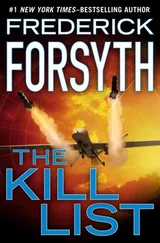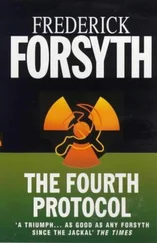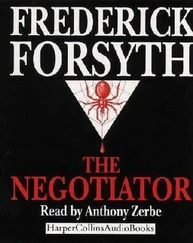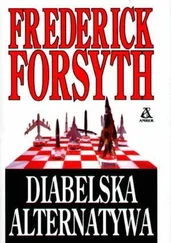Frederick Forsyth - The Devil's Alternative
Здесь есть возможность читать онлайн «Frederick Forsyth - The Devil's Alternative» весь текст электронной книги совершенно бесплатно (целиком полную версию без сокращений). В некоторых случаях можно слушать аудио, скачать через торрент в формате fb2 и присутствует краткое содержание. Жанр: Шпионский детектив, на английском языке. Описание произведения, (предисловие) а так же отзывы посетителей доступны на портале библиотеки ЛибКат.
- Название:The Devil's Alternative
- Автор:
- Жанр:
- Год:неизвестен
- ISBN:нет данных
- Рейтинг книги:5 / 5. Голосов: 1
-
Избранное:Добавить в избранное
- Отзывы:
-
Ваша оценка:
- 100
- 1
- 2
- 3
- 4
- 5
The Devil's Alternative: краткое содержание, описание и аннотация
Предлагаем к чтению аннотацию, описание, краткое содержание или предисловие (зависит от того, что написал сам автор книги «The Devil's Alternative»). Если вы не нашли необходимую информацию о книге — напишите в комментариях, мы постараемся отыскать её.
The Devil's Alternative — читать онлайн бесплатно полную книгу (весь текст) целиком
Ниже представлен текст книги, разбитый по страницам. Система сохранения места последней прочитанной страницы, позволяет с удобством читать онлайн бесплатно книгу «The Devil's Alternative», без необходимости каждый раз заново искать на чём Вы остановились. Поставьте закладку, и сможете в любой момент перейти на страницу, на которой закончили чтение.
Интервал:
Закладка:
“Your cabin, if you please, Captain.”
In single file, Larsen leading, the leader of the terrorists next, and one of his henchmen with a submachine carbine bringing up the rear, the three men descended the stairs from the bridge to D deck, one flight below. Halfway down the stairs, at the turn, Larsen turned to look back and up at his two captors, measuring the distances, calculating whether he could overcome them both.
“Don’t even try it,” said the voice behind the mask at his shoulder. “No one in his right mind argues with a submachine gun at a range of ten feet.”
Larsen led them onward down the stairs. D deck was the senior officers’ living quarters. The captain’s suite was in the extreme starboard corner of the great sweep of superstructure. Moving to port, next came a small chart library, the door open to reveal locker after locker of high-quality sea charts, enough to take him into any ocean, any bay, any suitable anchorage in the world. They were all copies of originals made by the British Admiralty, and the best in the world.
Next was the conference suite, a spacious cabin where the captain or owner could, if he wished, receive a sizable number of visitors all at one time. Next to this were the owner’s staterooms, closed and empty, reserved for the chairman, should he ever wish to sail with his ship. At the port end was another suite of cabins identical but in reverse to the captain’s quarters. Here the chief engineer lived.
Aft of the captain’s cabins was the smaller suite for the first officer, and aft of the chief engineer dwelt the chief steward. The whole complex formed a hollow square, whose center was taken up by the flight of stairs going around and around and downward to A deck, three levels below.
Thor Larsen led his captors to his own cabin and stepped into the dayroom. The terrorist leader followed him in and quickly ran through the other rooms, bedroom and bathroom. There was no one else present.
“Sit down, Captain,” he said, the voice slightly muffled by the mask. “You will remain here until I return. Please do not move. Place your hands on the table and keep them there, palms downward.”
There was another stream of orders in a foreign language, and the machine gunner took up a position with his back to the far bulkhead of the cabin, facing Thor Larsen but twelve feet away, the barrel of his gun pointing straight at the white crew-neck sweater Thor Larsen wore. The leader checked to see that all the curtains were well drawn, then left, closing the door behind him. The other two inhabitants of the deck were asleep in their respective cabins and heard nothing. Within minutes the leader was back on the bridge.
“You”—he pointed his gun at the boyish seaman—“come with me.”
The lad looked imploringly at First Officer Stig Lundquist.
“You harm that boy and I'll personally hang you out to dry,” said Tom Keller in his American accent. Two submachine-gun barrels moved slightly in the hands of the ring of men around him.
“Your chivalry is admirable, your sense of reality deplorable,” said the voice behind the leader’s mask. “No one gets hurt unless you try something stupid. Then there’ll be a bloodbath, and you’ll be right under the taps.”
Lundquist nodded to the seaman.
“Go with him,” he said. “Do what he wants.”
The seaman was escorted back down the stairs. At the D deck level, the terrorist stopped him.
“Apart from the captain, who lives on this deck?” he asked.
“The chief engineer, over there,” said the seaman. “The first officer, over there, but he’s up on the bridge now. And the chief steward, there.”
There was no sign of life behind any of the doors.
“The paint locker, where is it?” asked the terrorist. Without a word the seaman turned and headed down the stairs. They went through C deck and B deck. Once a murmur of voices came to them, from behind the door of the seamen’s messroom, where four men who could not sleep were apparently playing cards over coffee.
At A deck they had reached the level of the base of the superstructure. The seaman opened an exterior door and stepped outside. The terrorist followed nun. The cold night air made them both shiver after the warmth of the interior. They found themselves aft of the superstructure on the poop. To one side of the door from which they emerged, the bulk of the funnel towered a hundred feet up toward the stars.
The seaman led the way across the poop to where a small steel structure stood. It was six feet by six and about the same in height. In one side of it there was a steel door, closed by two great screw bolts with butterfly nuts on the outside.
“Down there,” said the seaman.
“Go on down,” said the terrorist. The boy spun the twin butterfly handles, unscrewing the cleats, and pulled them back. Seizing the door handle, he swung it open. There was a light inside, showing a tiny platform and a steel stairway running down to the bowels of the Freya . At a jerk from the gun, the seaman stepped inside and began to head downward, the terrorist behind him.
Over seventy feet of the stairs led down, past several galleries from which steel doors led off. When they reached the bottom they were well below waterline, only the keel beneath the deck plating under their feet. They were in an enclosure with four steel doors. The terrorist nodded to the one facing aft.
“What’s that lead to?”
“Steering-gear housing.”
“Let’s have a look.”
When the door was open, it showed a great vaulted hall all in metal and painted pale green. It was well lit. Most of the center of the deck space was taken up by a mountain of encased machinery the device which, receiving its orders from the computers of the bridge, would move the rudder. The walls of the cavity were curved to the nethermost part of the ship’s hull. Aft of the chamber, beyond the steel, the great rudder of the Freya would be hanging inert in the black waters of the North Sea. The terrorist ordered the door closed again and bolted shut.
Port and starboard of the steering-gear chamber were, respectively, a chemical store and a paint store. The chemical store the terrorist ignored; he was not going to make men prisoners where there was acid to play with. The paint store was better. It was quite large, airy, well ventilated, and its outer wall was the hull of the ship.
“What’s the fourth door?” asked the terrorist. The fourth was the only door with no handles.
“It leads to the rear of the engine room,” said the seaman. “It is bolted on the other side.”
The terrorist pushed against the steel door. It was rock-solid. He seemed satisfied.
“How many men on this ship?” he asked. “Or women. No tricks. If there is one more than the figure you give, we’ll shoot them.”
The boy ran his tongue over dry lips.
“There are no women,” he said. “There might be wives next trip, but not on the maiden voyage. There are thirty men, including Captain Larsen.”
Knowing what he needed to know, the terrorist pushed the frightened young man into the paint locker, swung the door closed, and threw one of the twin bolts into its socket. Then he returned back up the ladder.
Emerging on the poop deck, he avoided the interior stairs and raced back up the outside ladders to the bridge, stepping in from outside where they reached the bridgewing.
He nodded to his five companions, who still held the two officers at gunpoint, and issued a stream of further orders. Minutes later the two bridge officers, joined by the chief steward and chief engineer, roused from their beds on D deck below the bridge, were marched down to the paint locker. Most of the crew were asleep on B deck, where the bulk of the cabins were situated, much smaller than the officers’ accommodations above their heads, on C and D.
Читать дальшеИнтервал:
Закладка:
Похожие книги на «The Devil's Alternative»
Представляем Вашему вниманию похожие книги на «The Devil's Alternative» списком для выбора. Мы отобрали схожую по названию и смыслу литературу в надежде предоставить читателям больше вариантов отыскать новые, интересные, ещё непрочитанные произведения.
Обсуждение, отзывы о книге «The Devil's Alternative» и просто собственные мнения читателей. Оставьте ваши комментарии, напишите, что Вы думаете о произведении, его смысле или главных героях. Укажите что конкретно понравилось, а что нет, и почему Вы так считаете.










